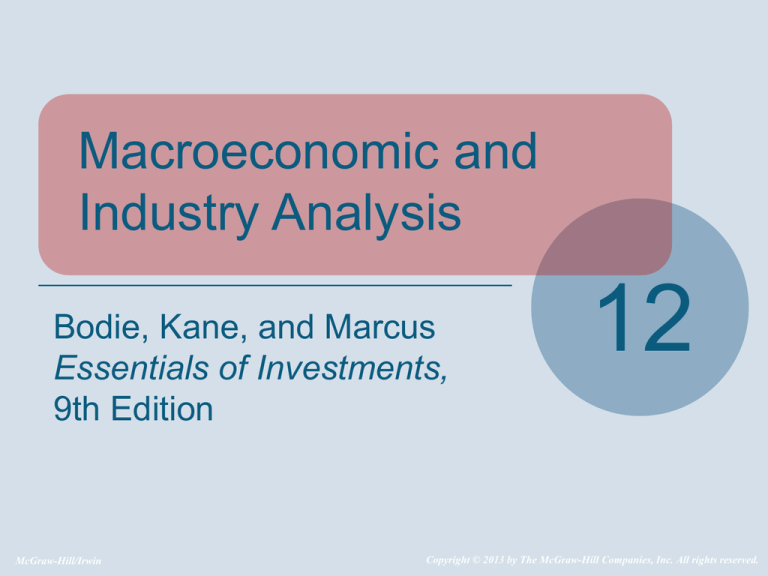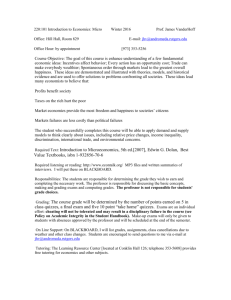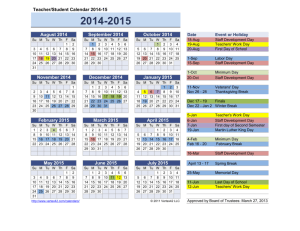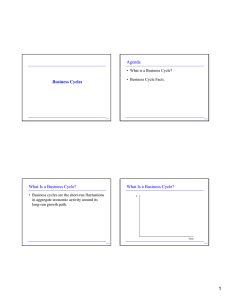
Macroeconomic and
Industry Analysis
Bodie, Kane, and Marcus
Essentials of Investments,
9th Edition
McGraw-Hill/Irwin
12
Copyright © 2013 by The McGraw-Hill Companies, Inc. All rights reserved.
12.1 Global Economy
• National Economic Environment
• Crucial determinant of industry performance
• Exchange Rate
• Rate at which domestic currency can be
converted into foreign currency
12-2
Table 12.1 Economic Performance
2011 Stock Market Return (%)
In Local Currency
In U.S. Dollars
Forecasted Growth in GDP, 2012 (%)
Brazil
-22.9
-28.9
3.5
Britain
-3.9
-4.2
0.2
Canada
-9.1
-10.9
2.0
China
-22.7
-19.1
8.2
France
-16.1
-19.2
-0.3
Germany
-11.6
-14.9
0.1
Greece
-53.2
-54.9
-7.5
India
-22.6
-34.6
7.8
Italy
-24.0
-26.9
-1.1
Japan
-16.3
-11.6
1.7
Mexico
-3.0
-12.9
3.1
Russia
-15.4
-19.0
3.7
Singapore
-15.0
-15.5
4.0
-9.0
-10.1
3.8
Thailand
0.3
-3.9
3.1
U.S.
1.6
1.6
2.0
South Korea
Source: The Economist, January 7, 2012
12-3
Figure 12.1 Change in Real Exchange Rate
U.S. dollar versus major currencies, 1999-2010
U.K.
4.3%
Euro
-13.4%
Japan
Canada
-35%
2.7%
-28.9%
-30%
-25%
-20%
-15%
-10%
-5%
0%
5%
10%
12-4
12.2 The Domestic Macroeconomy
• Gross Domestic Product (GDP)
• Market value of goods and services produced
over period of time
• Unemployment Rate
• Ratio of number of unemployed to total labor
force
• Inflation
• Rate at which general level of prices for goods
and services is rising
12-5
12.2 The Domestic Macroeconomy
• Interest Rates
• High interest rates reduce present value of
future cash flows
• Budget Deficit
• Government spending in excess of government
revenues
• Sentiment
• Consumer optimism/pessimism are
determinants of economic performance
12-6
Figure 12.2 S&P 500 Index versus Earnings per Share
2500
S&P 500
EPS x 12
EPS x 18
EPS x 25
2000
1500
1000
500
2011
2007
2003
1999
1995
1991
1987
1983
1979
1975
1971
1967
1963
1959
1955
0
12-7
12.3 Interest Rates
• Fundamental Factors of Interest Rates
• Supply of funds from savers
• Demand for funds from borrowers
• Government’s net supply/demand for funds,
modified by Federal Reserve
• Expected rate of inflation
12-8
Figure 12.3 Determination of Equilibrium Real Rate of Interest
12-9
12.4 Demand and Supply Shocks
• Demand Shock
• Event that affects demand for goods and
services in economy
• Supply Shock
• Event that influences production capacity and
costs in economy
12-10
12.5 Federal Government Policy
• Fiscal Policy
• Use of government spending and taxing for
stabilizing economy
• Monetary Policy
• Actions taken by Board of Governors of Federal
Reserve System to influence money supply or
interest rates
• Supply-Side Policies
• Address productive capacity of economy, goal is
to induce workers/owners to produce goods
12-11
12.6 Business Cycles
• Business Cycles
• Recurring cycles of recession and recovery
• Peak
• Transition from end of expansion to start of
contraction
• Trough
• Transition point between recession and recovery
12-12
12.6 Business Cycles
• Cyclical Industries
• Industries with above-average sensitivity to state
of economy
• Defensive Industries
• Industries with below-average sensitivity to state
of economy
12-13
Figure 12.4 Cyclical Indicators
12-14
Figure 12.4 Cyclical Indicators
12-15
12.6 Business Cycles
• Leading Economic Indicators
• Economic series that tend to rise or fall in
advance of rest of economy
• Stock-market-price index
• Money supply
• Manufacturers’ orders
12-16
Table 12.2 Indexes of Economic Indicators
12-17
Figure 12.5 Indexes of Leading, Coincident, and Lagging
Factors
12-18
Table 12.3 Economic Calendar
12-19
Figure 12.6 Economic Calendar at Yahoo!
For
Actual
Briefing
Forecast
3-Jan 10:00 AM Construction Spending
Nov
1.20%
0.20%
0.50%
-0.20%
0.80%
4-Jan
31-Dec -3.70%
NA
NA
-2.60%
—
4-Jan 10:00 AM Factory Orders
Nov
1.80%
2.60%
2.10%
-0.20%
-0.40%
5-Jan
8:15 AM ADP Employment Change
Dec
325K
200K
180K
204K
206K
5-Jan
8:30 AM Intial Claims
31-Dec 372K
375K
375K
387K
381K
5-Jan 10:00 AM ISM Services
Dec
52.6
53
53
52
—
6-Jan
8:30 AM Nonfarm Private Payrolls
Dec
212K
200K
170K
120K
140K%
6-Jan
8:30 AM Unemployment Rate
Dec
8.50%
8.70%
8.70%
8.70%
8.60%
6-Jan
8:30 AM Hourly Earnings
Dec
0.20%
0.10%
0.20%
0.00%
-0.10%
Date
Time
(ET)
Statistic
7:00 AM MBA Mortgage Index
Market
Expects
Prior
Revised
From
12-20
12.7 Industry Analysis
• Defining an Industry
• NAICS codes
• Classification of firms into industry groups
using numerical codes to identify industries
• Sensitivity to the Business Cycle
• Sensitivity of sales
• Operating leverage
• Financial leverage
12-21
Figure 12.7 Return on Equity, 2011
Computer systems
Restaurants
Application software
Industrial metals
Chemical products
Integrated oil & gas
Health care plans
Aerospace/defense
Pharmaceuticals
Home improvement
Telecom services
Business software
Asset management
Food products
Biotech
Trucking
Auto manufacturers
Electric utilities
Heavy construction
Money center banks
36.4
29.6
24.9
24.6
19.6
18.1
17.2
17.1
15.8
15.6
14.1
11.4
10.3
9.0
8.7
8.5
7.9
7.1
7.0
6.7
0.0
5.0
10.0
15.0
20.0
25.0
30.0
35.0
40.0
ROE (%)
12-22
Figure 12.8 Industry Stock Price Performance, 2011
Computer systems
Restaurants
Application software
Industrial metals
Chemical products
Integrated oil & gas
Health care plans
Aerospace/defense
Pharmaceuticals
Home improvement
Telecom services
Business software
Asset management
Food products
Biotech
Trucking
Auto manufacturers
Electric utilities
Heavy construction
Money center banks
-40.0
16.3
27.8
-8.6
-21.2
-4.6
13.4
10.5
5.5
14.7
12.9
-9.1
-8.6
-20.1
11.3
5.5
-7.7
-33.2
13.1
-17.1
-25.3
-30.0
-20.0
-10.0
0.0
10.0
20.0
30.0
Rate of return (%)
12-23
Figure 12.9 ROE of Application Software Firms
Adobe
15.2
CA (Computer Assoc)
15.5
Oracle
24.3
Intuit
25.7
SAP
26.0
Microsoft
44.2
0
5
10
15
20
25
30
35
40
45
50
ROE (%)
12-24
Table 12.5 Examples of NAICS Industry Codes
12-25
Figure 12.10 Industry Cyclicality
15%
Grocery
Jewelry
5%
0%
-5%
-10%
2011
2009
2007
2005
2003
2001
1999
1997
1995
-15%
1993
Annual sales growth (%)
10%
12-26
Figure 12.11 Stylized Depiction of Business Cycle
12-27
12.7 Industry Analysis
• Sector Rotation
• Shifting portfolio into industry sectors expected
to outperform others based on macroeconomic
forecasts
• After peak, defensive industries often better
performers
• In trough, capital goods industries often better
performers
• In expansion, cyclical industries often better
12-28
Figure 12.12 Sector Rotation
12-29
12.7 Industry Analysis
• Industry Life Cycles: Stages Firms Pass
Through to Maturity
• Start-up stage: Often characterized by new
technology/product
• Consolidation stage: Industry leaders begin to
emerge
• Maturity stage: Product has reached potential
for use by consumers
• Relative decline: May grow less than rest of
economy or shrink
12-30
Figure 12.13 Industry Life Cycle
12-31
12.7 Industry Analysis
• Industry Structure and Performance
• Threat of entry: New entrants to industry
pressure price/profits
• Rivalry between existing competitors: Market
share competition pressures price/profits
• Pressure from substitute products: Firms in
related industries can threaten market share
12-32
12.7 Industry Analysis
• Industry Structure and Performance
• Bargaining power of buyers
• Large-scale buyers have considerable
bargaining power
• Bargaining power of suppliers
• Large-scale suppliers have considerable
bargaining power
12-33







